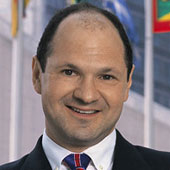Cruising the Caribbean
How much has first-class sea travel changed in the past century?
August 4, 2002
For centuries, much of long-distance travel had to be done by sea. Travelers spent weeks in enforced confinement on board extremely uncomfortable, dangerous vessels.
They had little drinking water. Their diets were frugal — and lacked variety. Scurvy, a disease caused by vitamin C deficiency, was widespread. Deadly perils included storms, disease, treacherous reefs and pirates.
But in the second half of the 19th century, all that changed. Great shipping lines that plied the routes between the Old and New Worlds commissioned huge, comfortable ships that catered to the rich and famous.
Moreover, shipping line operators soon realized that they had the exclusive attention of extremely wealthy people. They began creating a luxury atmosphere, complete with fine dining, expensive shopping and entertainment.
Unfortunately, the era of comfortable trans-Atlantic crossings by ship proved to be extremely short-lived. As ever more luxurious ocean liners were being constructed, the airplane emerged as a faster alternative to the old-fashioned sea voyage.
The days of the luxury ship seemed numbered. But then came ingenious cruise ship operators. They came up with a great idea — the Caribbean cruise. As a result of that brilliant invention, there are more people currently "sailing" the high seas than at any time in history.
And there are plenty of very comfortable ships — more like floating five-star hotels, in fact. The difference is that today's passengers are not forced to sail by the need to get from one place to another. On the contrary, they are actually going nowhere.
The idea of a Caribbean cruise is really a very simple one. First, take the image of a luxury oceanliner — and then sell it to the middle classes at affordable prices.
Next, get them onto your ship for several days with nothing else to do except shop and gamble. It's a marketer's dream come true! No wonder cruising is being so strongly marketed to U.S. vacationers — and is fast becoming the most popular form of travel among Americans.
Plenty of Europeans and Japanese also fly across the ocean to cruise the Caribbean on their vacations. Dozens of international cruise lines operate in the Caribbean, with such diverse names as Carnival, Mediterranean Shipping Cruises, Disney Cruises and Norwegian Cruise Lines.
Although the same business model has spread around the globe — to Europe, Latin America, Asia and elsewhere — the Caribbean remains an ideal place for cruise ships.
Its archipelago of small islands features several different cultures — British, American, Dutch, French and Hispanic. Yet, its population is so dependent on tourism that cruise ship companies have been able to shape them to their liking.
Over the past couple of decades, entire nations such as the Cayman Islands or the Bahamas have transformed themselves into amalgamations of duty-free shops catering exclusively to cruise ship passengers.
When your ship arrives at some exotic port of call, a trip to shore becomes a continuation of the shopping spree on board. Or, at best, a visit to a theme park.
Cruise ships bypass anything vaguely threatening, controversial — or unpleasant. That's why none make a stop in Cuba or in Haiti. And the port of call on Jamaica, called Ochos Rios, was specifically built away from the tough and unruly city of Kingston, the country's capital.
But the whole of Jamaica is still a dangerous place. Which is why the embarkation area is blocked off by barbed wire, while the streets where tourists are likely to congregate are patrolled by no-nonsense local police.
The cruise industry — like so many other service industries in rich countries — would not have been possible without globalization. Not only do people come from all over the world to cruise — they also come from all over to work.
On our boat, the Century, operated by Celebrity Cruises, some 2,000 passengers were served by around 800 staff — from quite a number of diverse nations.
But to my surprise, duties on board were strictly divided by nationality. The captain and the crew were Greek. The chefs were French, of course. Management, entertainers and sales staff came from the United States — or other developed countries, such as Canada, Australia and parts of Western Europe.
Waiters and cocktail waitresses were mainly from Eastern Europe and other "fringe" states.
As to busboys, cleaning personnel, housekeepers and maids, they were either Hispanic of Filipinos. Incidentally, low-level service staff got very small salaries, and their earnings came almost exclusively from tips.
Still, one wonders why these ships have so many service personnel. The answer, of course, is food. The Caribbean cruise is expected to provide massive quantities of food.
There are three all-you-can eat meals, plus such things as the mid-morning and afternoon pizza, the ice cream social, the afternoon tea — and, last but not least, the midnight buffet. By tradition, the night before final disembarkation features the Grand Buffet.
Somebody has to prepare all that food, serve it and clean up afterwards. The obsession with food is especially ironic in light of the privations that the ship passengers of the earlier times had to endure during their voyages. No damp biscuit or barrels of salt beef for today's sailors — pardon, cruisers.
On our ship, the Grand Buffet featured ice sculptures, shrimp with caviar and mountains of delicacies and cakes. Before we could dig in, there was a viewing session, at which passengers were encouraged to photograph and video-tape all that splendor.
But the passengers were a much more amazing sight than the gastronomical wonders: Men and women in evening dress falling over each other to film groaning tables of food. I wonder what our Filipino busboys thought about it.
Read previous
Asia and the American Model
August 2, 2002
